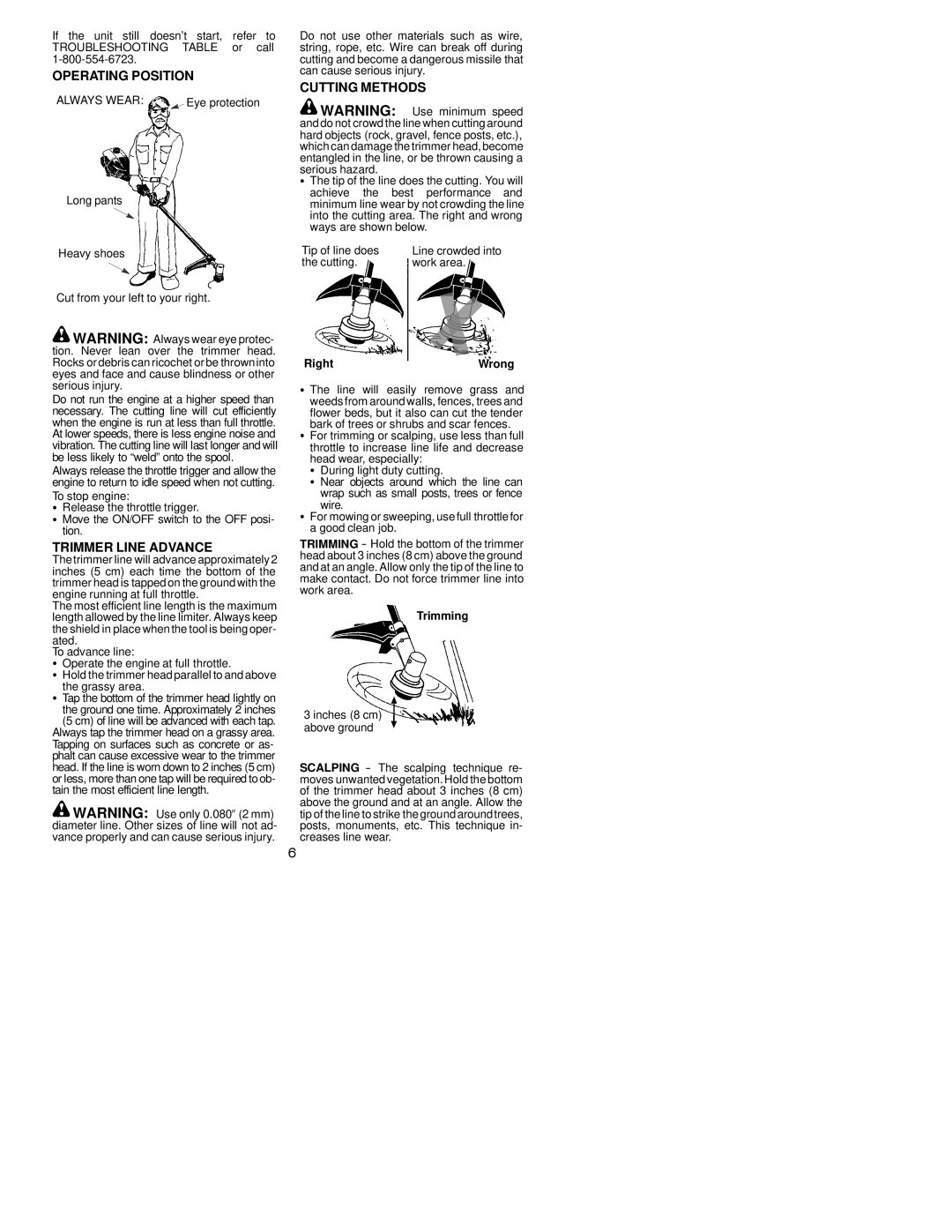
If the unit still doesn’t start, refer to TROUBLESHOOTING TABLE or call
OPERATING POSITION
ALWAYS WEAR: | Eye protection |
Long pants
Heavy shoes
Cut from your left to your right.
![]() WARNING: Always wear eye protec- tion. Never lean over the trimmer head. Rocks or debris can ricochet or be throwninto eyes and face and cause blindness or other serious injury.
WARNING: Always wear eye protec- tion. Never lean over the trimmer head. Rocks or debris can ricochet or be throwninto eyes and face and cause blindness or other serious injury.
Do not run the engine at a higher speed than necessary. The cutting line will cut efficiently when the engine is run at less than full throttle. At lower speeds, there is less engine noise and vibration. The cutting line will last longer and will be less likely to “weld” onto the spool.
Always release the throttle trigger and allow the engine to return to idle speed when not cutting. To stop engine:
SRelease the throttle trigger.
SMove the ON/OFF switch to the OFF posi- tion.
TRIMMER LINE ADVANCE
Thetrimmer line will advance approximately 2 inches (5 cm) each time the bottom of the trimmer head is tapped on the ground with the engine running at full throttle.
The most efficient line length is the maximum length allowed by the line limiter. Always keep the shield in place when the tool is being oper- ated.
To advance line:
SOperate the engine at full throttle.
SHold the trimmer head parallel to and above
the grassy area.
STap the bottom of the trimmer head lightly on
the ground one time. Approximately 2 inches (5 cm) of line will be advanced with each tap.
Always tap the trimmer head on a grassy area. Tapping on surfaces such as concrete or as- phalt can cause excessive wear to the trimmer head. If the line is worn down to 2 inches (5 cm) or less, more than one tap will be required to ob- tain the most efficient line length.
![]() WARNING: Use only 0.080! (2 mm) diameter line. Other sizes of line will not ad- vance properly and can cause serious injury.
WARNING: Use only 0.080! (2 mm) diameter line. Other sizes of line will not ad- vance properly and can cause serious injury.
Do not use other materials such as wire, string, rope, etc. Wire can break off during cutting and become a dangerous missile that can cause serious injury.
CUTTING METHODS
![]() WARNING: Use minimum speed and do not crowd the line when cutting around hard objects (rock, gravel, fence posts, etc.), which can damage the trimmer head, become entangled in the line, or be thrown causing a serious hazard.
WARNING: Use minimum speed and do not crowd the line when cutting around hard objects (rock, gravel, fence posts, etc.), which can damage the trimmer head, become entangled in the line, or be thrown causing a serious hazard.
SThe tip of the line does the cutting. You will achieve the best performance and minimum line wear by not crowding the line into the cutting area. The right and wrong ways are shown below.
Tip of line does | Line crowded into | ||||||
the cutting. | work area. | ||||||
|
|
|
|
|
|
|
|
|
|
|
|
|
|
|
|
|
|
|
|
|
|
|
|
|
|
|
|
|
|
|
|
|
|
|
|
|
|
|
|
RightWrong
S The line will easily remove grass and weeds from around walls, fences, trees and flower beds, but it also can cut the tender bark of trees or shrubs and scar fences.
SFor trimming or scalping, use less than full throttle to increase line life and decrease head wear, especially:
S During light duty cutting.
S Near objects around which the line can wrap such as small posts, trees or fence
wire.
SFor mowing or sweeping, use full throttlefor a good clean job.
TRIMMING
Trimming
3 inches (8 cm) above ground
SCALPING
6
